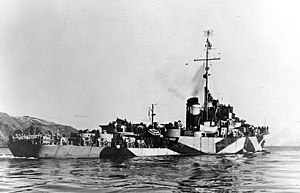USS Rockford
 USS Rockford (PF-48) painted in dazzle camouflage Measure 32, Design 16d, at Adak, Territory of Alaska, on 30 January 1945.
| |
| History | |
|---|---|
| Name | Rockford |
| Namesake | City of Rockford, Illinois |
| Reclassified | PF-48, 15 April 1943 |
| Builder | Wilmington, California |
| Yard number | 533 |
| Laid down | 28 August 1943 |
| Launched | 27 September 1943 |
| Sponsored by | Mrs. Harry L. Crotzer |
| Commissioned | 6 March 1944 |
| Decommissioned | 26 August 1945[1] |
| Honors and awards | 2 battle stars, World War II |
| Fate | Transferred to the Soviet Navy, 26 August 1945[2] |
| Acquired | Returned by Soviet Navy, 1 November 1949 |
| Fate | Transferred to Republic of Korea Navy, 23 October 1950 |
| Acquired | Returned by Republic of Korea Navy, 3 September 1952 |
| Stricken | 26 May 1953 |
| Fate | Sunk as target, 30 September 1953 |
| Name | EK-18[4] |
| Acquired | 26 August 1945[2] |
| Commissioned | 26 August 1945[3] |
| Fate | Returned to United States, 1 November 1949 |
| Name | ROKS Apnok (62) |
| Acquired | 23 October 1950 |
| Fate |
|
| General characteristics | |
| Class and type | Tacoma-class frigate |
| Displacement |
|
| Length | 303 ft 11 in (92.63 m) |
| Beam | 37 ft 6 in (11.43 m) |
| Draft | 13 ft 8 in (4.17 m) |
| Propulsion |
|
| Speed | 20 knots (37 km/h; 23 mph) |
| Complement | 190 |
| Armament |
|
USS Rockford (PF-48), a Tacoma-class frigate in commission from 1944 to 1945, thus far has been the only ship of the United States Navy to be named for Rockford, Illinois. She later served in the Soviet Navy as EK-18 and in the Republic of Korea Navy as ROKS Apnokkang (62).
Construction and commissioning
Originally classified as a patrol
Service history
Following
On 2 August 1944, Rockford moored in Milne Bay, New Guinea, and then operated on convoy escort duty and antisubmarine patrol off the New Guinea coast until 23 September 1944, when she made a brief run to Manus Island in the Admiralty Islands.
Rockford then returned to New Guinea, remaining there until 15 October 1944, when she began a voyage to the
On 17 November 1944, Rockford arrived on the U.S. West Coast for scheduled repairs. After their completion, she reported for duty on 4 January 1945 to Commander,
group.Selected for transfer to the Soviet Navy in Project Hula – a secret program for the transfer of U.S. Navy ships to the Soviet Navy at Cold Bay in anticipation of the Soviet Union joining the war against Japan – Rockford began training her new Soviet crew at Cold Bay in August 1945.[5]
Following the completion of training for her Soviet crew, Rockford was
In February 1946, the United States began negotiations for the return of ships loaned to the Soviet Union for use during World War II. On 8 May 1947,
Reverting to her original name, Rockford lay idle in the
Disposal
Reverting to her original name and assigned a status of "inactive out of commission in reserve" by the U.S. Navy, Rockford was struck from the
on 30 September 1953.Awards
The U.S. Navy awarded Rockford two
References
- This article incorporates text from the public domain Dictionary of American Naval Fighting Ships. The entry can be found here.
- ^ large infantry landing craft (LCI(L)s) and information on p. 27 about the transfer of USS Coronado (PF-38), which Russell says typified the transfer process. As sources, Russell cites Department of the Navy, Ships Data: U.S. Naval Vessels Volume II, 1 January 1949, (NAVSHIPS 250-012), Washington, DC: Bureau of Ships, 1949; and Berezhnoi, S. S., Flot SSSR: Korabli i suda lendliza: Spravochnik ("The Soviet Navy: Lend-Lease Ships and Vessels: A Reference"), St. Petersburg, Russia: Belen, 1994.
- ^ ISBN 0-945274-35-1, p. 39, which includes access to Soviet-era records unavailable during the Cold War, reports that the transfer date was 26 August 1945. As sources, Russell cites Department of the Navy, Ships Data: U.S. Naval Vessels Volume II, 1 January 1949, (NAVSHIPS 250-012), Washington, DC: Bureau of Ships, 1949; and Berezhnoi, S. S., Flot SSSR: Korabli i suda lendliza: Spravochnik ("The Soviet Navy: Lend-Lease Ships and Vessels: A Reference"), St. Petersburg, Russia: Belen, 1994.
- ^ large infantry landing craft (LCI(L)s) and information on p. 27 about the transfer of USS Coronado (PF-38), which Russell says typified the transfer process. As sources, Russell cites Department of the Navy, Ships Data: U.S. Naval Vessels Volume II, 1 January 1949, (NAVSHIPS 250-012), Washington, DC: Bureau of Ships, 1949; and Berezhnoi, S. S., Flot SSSR: Korabli i suda lendliza: Spravochnik ("The Soviet Navy: Lend-Lease Ships and Vessels: A Reference"), St. Petersburg, Russia: Belen, 1994.
- ^ ISBN 0-945274-35-1, p. 39, which includes access to Soviet-era records unavailable during the Cold War, reports that the ship's Soviet name was EK-18. As sources, Russell cites Department of the Navy, Ships Data: U.S. Naval Vessels Volume II, 1 January 1949, (NAVSHIPS 250-012), Washington, DC: Bureau of Ships, 1949; and Berezhnoi, S. S., Flot SSSR: Korabli i suda lendliza: Spravochnik ("The Soviet Navy: Lend-Lease Ships and Vessels: A Reference"), St. Petersburg, Russia: Belen, 1994.
- ^ ISBN 0-945274-35-1, p. 39.
- ISBN 0-945274-35-1, pp. 37–38, 39.
- ^ NavSource Online: Patrol Frigate Photo Archive: Rockford (PF-48) ex-PG-156
- ^ United States Navy Naval History and Heritage Command Korean War: Chronology of U.S. Pacific Fleet Operations, May 1952
External links
- Photo gallery of USS Rockford at NavSource Naval History
- hazegray.org: USS Rockford
